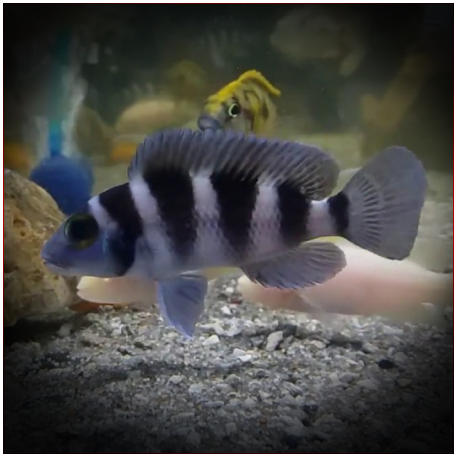More info
Datasheet
| Minimum Tank Size | 200 litres / 52.83 US gallons |
| Maximum Size | 15.2cm / 5.98inches |
| Temperament | Aggressive |
| Care Description | Easy |
| Temperature | 22.2°C / 71.96°F - 27.8°C / 82.04°F |
| Carbonate Hardness | 10-20 |
| pH | 7.8-9.0 |
General Description
The Tretocephalus Cichlid, also known as the Five-bar Cichlid, hails from the coastal waters of Lake Tanganyika, Africa. It shares similarities in appearance with the Frontosa but distinguishes itself with only five distinctive stripes. This species showcases a tan coloration, adding to its visual appeal. With an average size reaching up to 15.2cm, this cichlid displays an aggressive temperament, making it essential to house them with similar cichlid species in aquarium settings.
Aquarium Setup
To accommodate the Tretocephalus Cichlid, a minimum tank size of 200 liters is recommended, providing ample space for territorial behavior among the inhabitants (see table). Setting up the aquarium should incorporate numerous rocks with caves and a sand substrate predominantly made of aragonite. These elements not only create territorial divisions but also aid in maintaining the required high pH levels and alkalinity suitable for the species to thrive.
Behaviour
Known for its aggressive nature, the Tretocephalus Cichlid should be housed with other cichlid species that can match its temperament. In an aquarium environment, they will exhibit territorial behavior, often asserting dominance within their designated spaces. Therefore, it is crucial to provide adequate hiding spots and territories to minimize potential conflicts among tankmates.
Feeding and Diet
Being omnivorous, the diet of the Tretocephalus Cichlid should consist of a variety of foods ranging from meaty to vegetable-based sources. This should include offerings such as brine shrimp, bloodworms, as well as Spirulina-based flakes and pellets. Ensuring a balanced diet will promote their overall health and vitality in captivity.
Reproduction & Dimorphism
Breeding the Tretocephalus Cichlid can prove more challenging compared to other cichlid species, as they are cave spawners. Setting up the aquarium with numerous caves featuring sandy bottoms is essential for successful breeding. After an incubation period of 3 to 4 days, the female will safeguard the young. Newly hatched brine shrimp and finely crushed flake foods are ideal sustenance for the fry during their early stages of development.
Habitat and Distribution
Originating from Lake Tanganyika in Africa, the Tretocephalus Cichlid thrives in the coastal waters of this region. The species prefers habitats with rocky structures and caves, which serve as shelter and breeding grounds. Maintaining water parameters within the range of pH 7.8-9.0, temperature between 22.2-27.8°C, and a carbonate hardness of 10-20 dKH mimics their natural habitat, ensuring their well-being in captivity.

